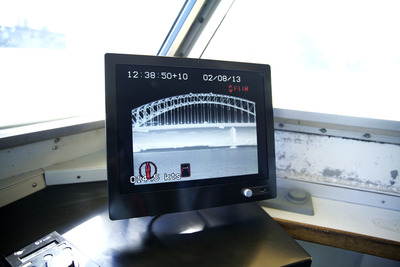Harbour City Ferries uses thermal imaging to improve safety
Monday, 28 October, 2013
Harbour City Ferries has significantly improved safety of its staff, vessels and other users of Sydney Harbour with installation of FLIR M320L thermal imaging cameras across its entire fleet.
Harbour City Ferries operates approximately 175,000 services, transporting nearly 15 million people 1.3 million kilometres across the busy and scenically beautiful Sydney Harbour and the Parramatta River each year. With all this activity and Harbour City Ferries’ strategic focus on safety, it was decided to install thermal imaging cameras on board the entire fleet of 28 vessels, six of which are double-enders, so 34 FLIR M320L cameras were purchased in total.
The Sydney Harbour Bridge casts a radar shadow underneath it that limits the utility of radar in the area. The usefulness of radar is also adversely affected if the target vessel is small and not constructed of radar-reflective materials or does not have a radar reflector installed on it.
Downlighting from the Harbour Bridge along with background lighting and reflections off the water can also make spotting some vessels difficult. So in 2009, Sydney Ferries (as it was then known) advanced the technology of its fleet by including the installation of FLIR M320L cameras to assist in night-time and low-visibility navigation.

“Although thermal imaging cameras produce clear images in total darkness, we are also operating during the twilight hours of the day, when some sunlight or moonlight is present. Also, during docking operations there is some light from the marina present. For these situations we wanted a low-light camera as well,” stated Glenn Young, Harbour City Ferries general manager operations and asset management
The joystick is on each bridge console, as close to the wheel as possible, so all features are right at the fingertips. The M320L provides crisp, clear thermal imagery in total darkness and light fog or smoke. The ergonomic M-Series joystick control unit provides ready access to all critical system functions and smooth, effortless control, even in rough seas. The radar shadow and visibility issues cast by the Sydney Harbour Bridge are not an issue with thermal imaging technology.
“When we understood that Sydney Ferries wanted to have a combination of a thermal imaging camera and a low-light camera, we decided to demonstrate the FLIR M320L,” said Paul Garske, general manager of Coursemaster Autopilots.
Installation of the FLIR M320L commenced in 2009 along with other Navaids equipment, supplied, installed and supported by Electrotech Australia. “The FLIR thermal imaging cameras are navigational aids for the masters and crew of the ferries to assist during times of poor visibility, such as fog, rain, glare, low light and at night,” said Stephen Penny, project manager of Electrotech. The systems are also used for incident recording in conjunction with GPS, time stamp and speed overlay; all of which were installed by Electrotech.
“At Harbour City Ferries we decided to connect the M320L to one dedicated 15″ Hatteland LCD screen. The master can easily switch from the image of the low-light camera to the thermal image, and back, whenever he wants, at the touch of a button. The cameras are set up in home position, which is useful, and each master also sets them to their own personal preferences,” said Young.
“The feedback that we are receiving from masters on the FLIR M320L has been great,” said Young.
“They all report that the M320L helps them to get a better understanding of what is happening around their vessel. They find it extremely easy to use and the joystick allows the master to operate all the features of the M320L such as pan/tilt or switching from daylight to thermal image. The joystick is on each bridge console, as close to the wheel as possible, so all features are right at the master’s fingertips.
Prior to the thermal camera installs, ferry masters were regularly radioing warnings of unlit kayakers and other vessels, fearing the possibility of a fatal collision. “Small craft are difficult to spot using radar,” said ferry master Wayne Pritchard. “They are designed so they don’t have a lot of superstructure above the water so it is difficult for the radar to pick them up.” Now armed with the FLIR M-Series thermal imaging cameras the masters have a clear view of the water, even in total darkness. One ferry master even commenting that the FLIR was the only reason he was able to spot an unlit kayaker in time to avoid a collision.
Sightings of unlit vessels, usually small boats that are not required to carry fixed lights, are common, but there are also regular sightings of unlit vessels that ought to have fixed navigation lights illuminated at night.
Using data to beat the energy crisis
National Ceramic Industries Australia has enlisted the help of OFS to tackle the energy crisis...
Multimeter safety in Australia
Recent serious incidents involving multimeters have highlighted the risks of using them when...
Top 10 tips for keeping safe this winter
As Australians pull heaters and electric blankets out of storage and spend more time indoors,...




